AQLI News
September 25, 2023

September 25, 2023
Our latest report from the Air Quality Life Index (AQLI) reveals the immense toll air pollution can have on life expectancy. Explore our data in the form of 10 easy-to-digest charts that uncover the most compelling findings. These findings show the severity of the problem, but also the benefits strong policies could bring to improve our health and lengthen our lives.

Particulate air pollution (PM2.5) remains the world’s greatest external risk to human health. Yet, the countries that are most impacted by air pollution lack the fundamental tools to combat it. Asia and Africa contribute 92.7 percent of life years lost due to pollution. But, just 6.8 and 3.7 percent of governments in these countries provide their citizens with fully open air quality data that is needed to encourage action and inform policies. And, while Europe, the United States and Canada—which contribute 4.2 percent of life years lost due to pollution—receive 60.4 percent of philanthropic funds to combat air pollution, just a small sliver goes towards pollution in Asia and Africa. Africa, in fact, receives philanthropic funding for air pollution equivalent to the current average price of a single-family home in the United States.
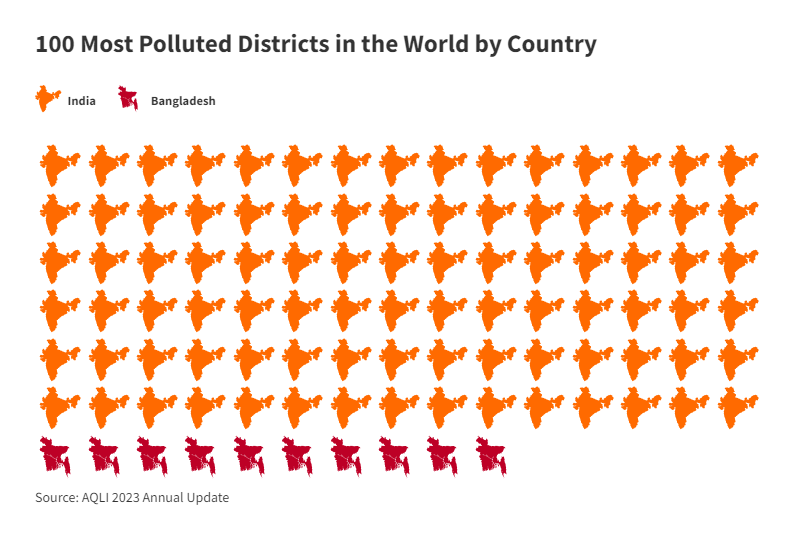
Large swaths of India experience the worst air pollution in the world. In fact, out of the top 100 polluted districts globally, 90 of them are in India. The top 77 most polluted districts are all in India, with the first polluted district outside of India–number 78–being in Bangladesh. Since 2013, 59.1 percent of the world’s increase in pollution has come from India—with particulate pollution (PM2.5) on average more than 10 times the World Health Organization (WHO) guideline. India as a whole faces the greatest health burden from its air pollution compared to anywhere else due to the large number of people it affects. The average Indian resident is set to lose 5.3 years of life expectancy if the WHO guideline is not met.
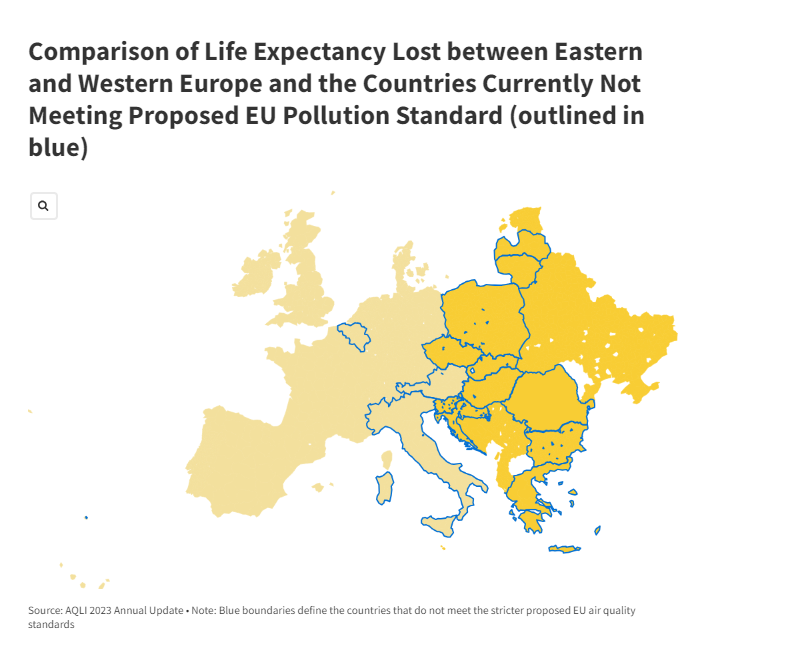
Despite improvements in air quality over the last two decades, Europeans today are breathing starkly different air. The western portion of the continent experiences generally cleaner air compared to the east, where virtually all of the populations of Poland, Belarus, Slovakia, Hungary, Lithuania, Armenia, and Bosnia and Herzegovina do not meet the World Health Organization’s (WHO) guideline for particulate pollution (PM2.5). And, they’re living shorter lives because of it. Eastern Europeans are losing 6.3 months more off their lives compared to their western neighbors. As the European Union tightens its air pollution standard, 15 out of 28 member countries will not be in compliance. Almost all of those countries are in Eastern Europe.
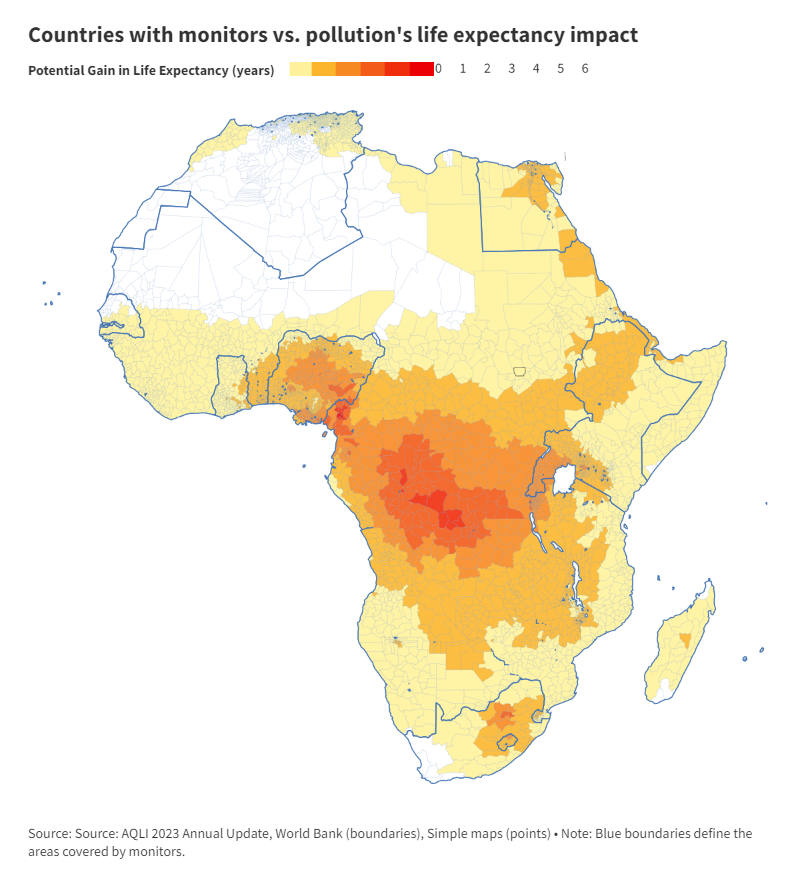
Central and West Africa has become a major global pollution hotspot as fossil fuel use continues to grow. In the most polluted areas of the region, pollution levels are 12 times the World Health Organization guideline and taking as much as 5.4 years off lives. Despite now being highly polluted, none of the 27 countries in Central and West Africa have a national pollution standard to provide a benchmark for pollution policies. And, just 3.7 percent of countries in all of Africa have fully transparent air quality monitoring data. Yet, there is an outsized opportunity to reverse this inequality. While air pollution is now as much of a health threat in Central and West Africa as well-known killers in the region like HIV/AIDS and malaria, $20.7 billion in aid went to HIV/AIDS and malaria and under $300,000 went to combat air pollution. More funding and air quality monitoring would go a long way in providing the basic building blocks African citizens and governments need to effect change.

Measured in terms of life expectancy, the AQLI reveals that particulate pollution (PM2.5) is consistently the world’s greatest external risk to human health. Pollution is set to reduce global average life expectancy by 2.3 years. That means, the impact of pollution on life expectancy is comparable to that of tobacco use, 3.8 times that of alcohol use and unsafe water sanitation and handwashing, 5.8 times that of transport injuries, 7.6 times that of HIV/AIDS, and 23 times that of nutritional deficiencies. Yet, while important issues like HIV/AIDS receive 654 million USD annually from philanthropic foundations worldwide, outdoor air pollution receives less than a tenth of that amount (63.8 million USD) despite its larger global health burden.
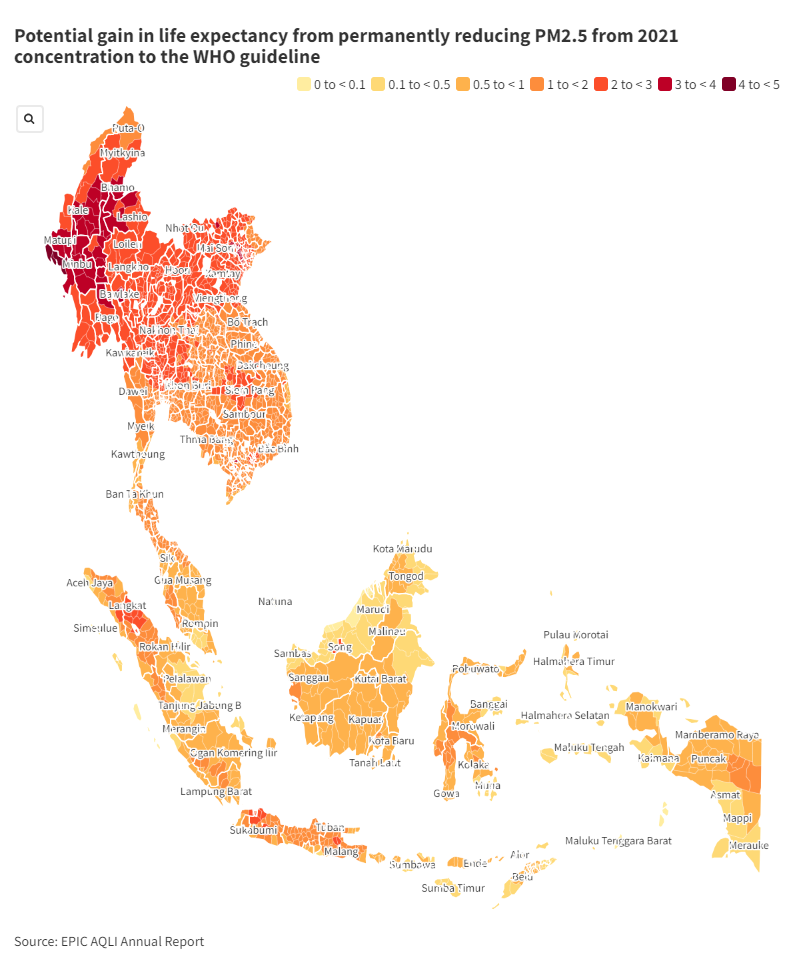
Almost all of Southeast Asia—99.9 percent—is now considered to have unsafe levels of particulate pollution (PM2.5), leading to 1.1 billion total life years lost across the eleven countries that make up the region due to air pollution in 2021, relative to if the WHO guideline was met. Residents living in some of the region’s largest cities are experiencing the greatest impacts. For example, those living in the cities of Mandalay (Myanmar), Hanoi (Vietnam) and Jakarta (Indonesia) are expected to lose 2 to more than 3 years of life expectancy on average if high pollution persists. While highly-populated regions saw high pollution levels, so did areas that experienced fires. For example, fire-prone northern Thailand—such as Phayao—experienced pollution levels that were 20 µg/m3 higher than levels in southern areas—such as Phuket. Those living in Phayao could live 11 months less than residents of Phuket due to this pollution variation, if the disparity persists.
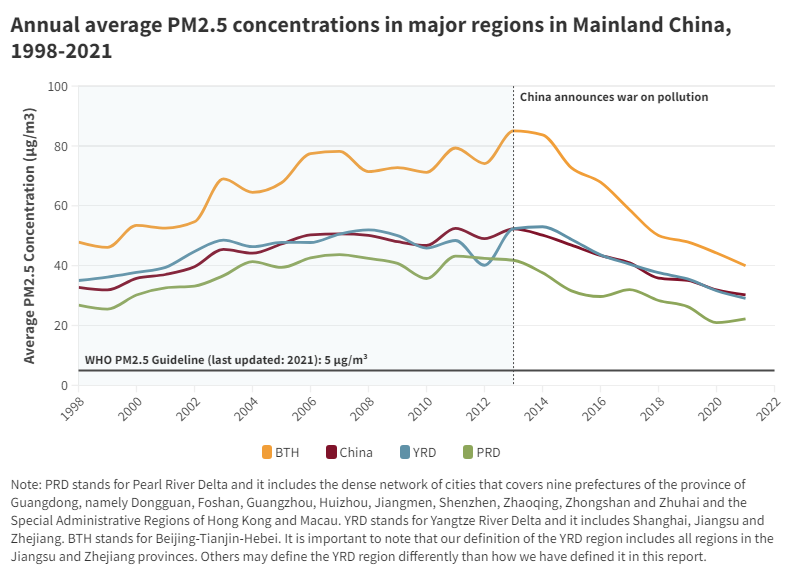
Despite significant increases in particulate pollution (PM2.5) in many regions of the world, global pollution has declined since 2013. That decline is due entirely to China’s success in steeply reducing pollution since declaring a “war against pollution” in 2014 after the country experienced some of its highest pollution levels. Swift policy actions led pollution in China to decline by 42.3 percent between 2013 and 2021, extending the average person’s life expectancy by 2.2 years if these reductions in pollution are sustained. Beijing province experienced the largest decline in pollution, dropping 56.2 percent in just eight years. The average person living there could expect to live 4.2 years longer.
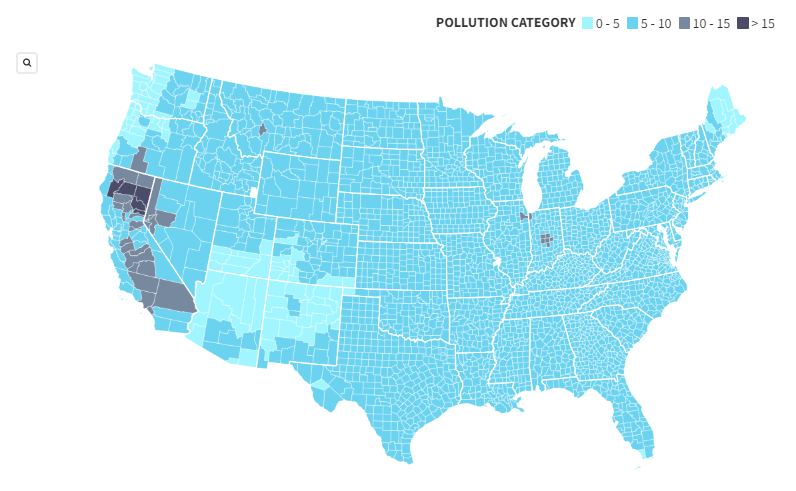
California leads the nations as the most polluted state thanks mostly to recurring catastrophic wildfires. Out of the top 30 most polluted U.S. counties, 20 of them were in California in 2021—a year in which California experienced its second worst wildfire season in terms of acreage burned and its largest single wildfire. Residents of California’s Central Valley are now consistently exposed to average particulate pollution levels (PM2.5) above both the WHO guideline and the nation’s own air quality standard. In Plumas County—the most polluted county in the United States—residents would gain 2.1 years of life expectancy if the region met the WHO guideline.

The health focus in Sub-Saharan Africa has centered on infectious diseases like HIV/AIDS and malaria, which receives $4 billion annually through global philanthropy . But the Air Quality Life Index (AQLI) shows that air pollution—receiving less than $300,000 annually on the African continent —impacts life expectancy in a comparable and sometimes more devastating way than these other causes. That is certainly the case in the Democratic Republic of the Congo (DRC)—the most polluted country in the region and seventh most polluted globally—where particulate pollution in 2021 was nearly 7 times higher than the World Health Organization guideline. As a result, the average resident of the DRC is losing 2.9 years off their life expectancy. That’s compared to just 3.6 months due to HIV/AIDS. Across Central and West Africa—home to more than 600 million people living in 27 countries —the average person is set to lose 1.6 years off their lives if the current levels of pollution persist.
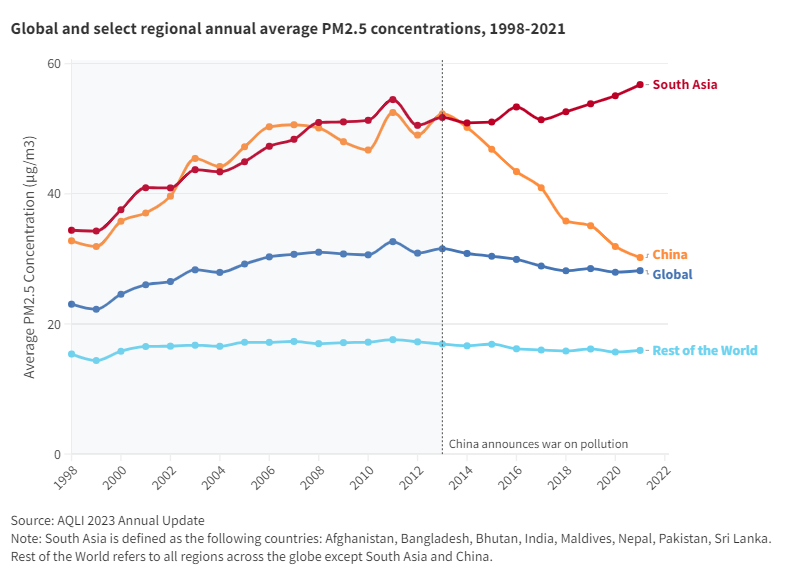
Over the past two decades, particulate pollution (PM2.5) levels have remained fairly constant for most of the world. However, since 2013, air pollution’s course has been made up of two competing regional trends. China has had staggering success in combating pollution since declaring a “war on pollution” in 2014, reducing its pollution by about 42 percent from 2013 to 2021. This decrease in pollution is extending its population’s average life expectancy by 2.2 years, provided the reductions are sustained. In fact, a small decline in global pollution levels from 2013 to 2021 is due entirely to China’s progress.
Meanwhile, 59 percent of the world’s increase in pollution over that time came from India. India and its neighboring South Asian countries of Bangladesh, Nepal and Pakistan saw their pollution increase by almost 10 percent from 2013 to 2021. Much of this increase in pollution is due to the burning of high amounts of fossil fuels without the policy safeguards China and other countries have imposed. And, it’s having a devastating impact on South Asian lives. As of 2021, more than half of the total life years lost globally due to high pollution came from South Asia, with South Asians on average seeing their lives cut short by 5 years due to high pollution.